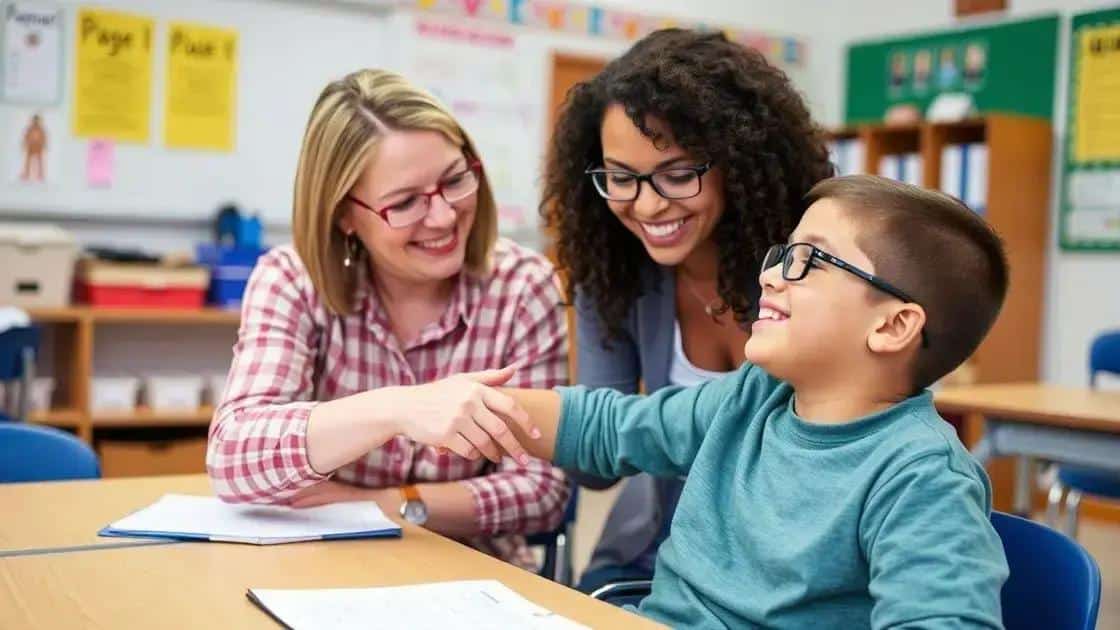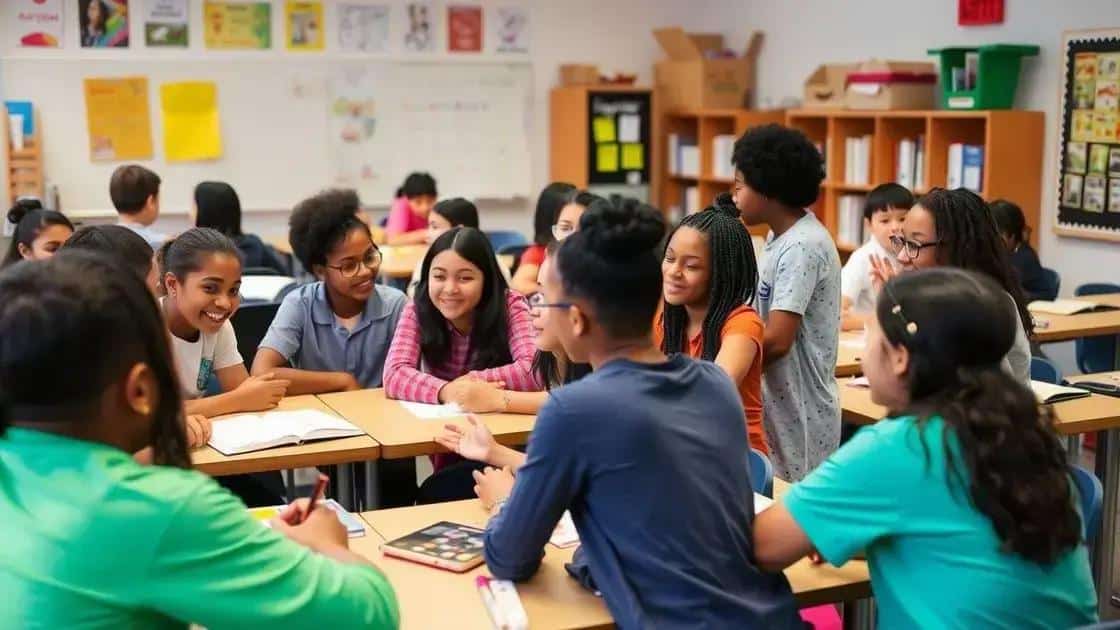Share learning disability support to empower growth

Share learning disability support involves collaborative efforts from teachers and parents, utilizing effective strategies and resources to create inclusive environments that empower individuals with learning disabilities to thrive.
Share learning disability support and open doors for those in need. Have you ever wondered how you can make a difference in someone’s learning journey? This article dives into practical ways to provide meaningful support and understanding.
Understanding learning disabilities
Understanding learning disabilities is crucial for fostering a supportive environment. Learning disabilities are neurological disorders that affect how individuals process information. This can lead to challenges in reading, writing, math, and more.
Types of Learning Disabilities
There are several types of learning disabilities people may experience. For example, dyslexia impacts reading ability, while dyscalculia affects mathematical skills. Knowing about these types helps us understand different needs.
- Dyslexia: Difficulty in reading and fluency.
- Dysgraphia: Challenges in writing and fine motor skills.
- Dyscalculia: Trouble with numbers and mathematical concepts.
- Auditory and Visual Processing Disorders: Issues with interpreting sounds or visuals effectively.
Additionally, it’s important to note that learning disabilities are often invisible, meaning individuals might not appear any different from their peers. This can lead to misunderstandings and frustration.
The Importance of Early Identification
Identifying learning disabilities early can significantly impact a child’s success. When parents and educators recognize signs, they can implement strategies tailored for each child’s needs. For instance, providing extra time on tests can help level the playing field.
Moreover, a strong support system, including teachers, parents, and specialists, is essential. They can work together to create customized learning plans that help children thrive.
Creating an Inclusive Environment
Creating an inclusive environment is key to supporting those with learning disabilities. This means making adjustments in classrooms and encouraging open communication. For example, using visual aids and hands-on activities can enhance learning experiences.
Furthermore, promoting kindness and understanding among students fosters an atmosphere of support. When classmates learn to appreciate each other’s differences, it enhances social interactions and builds confidence.
By focusing on understanding learning disabilities, we can empower individuals to reach their fullest potential. It’s essential to advocate for resources and awareness in schools so that everyone receives the support they need.
Effective strategies for support
When it comes to providing support for individuals with learning disabilities, implementing effective strategies can make a world of difference. These strategies not only help improve academic performance but also boost confidence and self-esteem.
Personalized Learning Plans
Creating a personalized learning plan is essential. Each student has unique strengths and weaknesses, so tailoring support to meet their specific needs is key. This plan should include specific goals, resources, and strategies that work best for the individual.
- Assess the student’s strengths and weaknesses.
- Incorporate different learning styles, such as visual and auditory methods.
- Set realistic and achievable goals.
- Regularly review and adjust the plan as needed.
Moreover, using technology can enhance learning experiences. Tools like educational software and apps designed for students with learning disabilities can provide interactive and engaging methods for practicing skills.
Creating a Supportive Environment
A supportive environment is crucial for helping students succeed. This includes fostering an atmosphere of understanding and acceptance in the classroom. Teachers can promote inclusivity by encouraging collaboration among students and emphasizing teamwork.
Additionally, establishing clear routines can provide structure that helps students feel more secure. When they know what to expect, it reduces anxiety and supports better focus on learning.
Collaboration with Parents and Specialists
Collaboration is another effective strategy. Engaging with parents and specialists, such as counselors and therapists, ensures a comprehensive support system. Regular communication helps parents stay informed about their child’s progress and any challenges they may face.
Involving parents in the educational process creates a stronger support network. Teachers can suggest activities and resources for parents to use at home, reinforcing skills learned at school.
By understanding and implementing these effective strategies for support, educators and families can help individuals with learning disabilities thrive academically and socially.
Creating inclusive environments

Creating inclusive environments is vital for supporting individuals with learning disabilities. An inclusive environment ensures that every student feels welcome, valued, and capable of learning at their own pace.
Understanding Inclusivity
Inclusivity goes beyond just being present; it means actively engaging everyone in the learning process. It involves understanding the diverse needs of all students and adapting teaching methods accordingly. Teachers play a crucial role in fostering this sense of belonging.
- Encourage participation from all students.
- Use diverse teaching materials that reflect different cultures and experiences.
- Implement flexible seating arrangements that suit various learning styles.
- Promote a growth mindset by encouraging perseverance and effort.
Creating an inclusive classroom also involves recognizing and addressing barriers to learning. These may include physical obstacles or social dynamics that can inhibit a student’s ability to participate fully. Regularly evaluating these elements is crucial for improvement.
Training and Resources for Educators
Providing training for educators is essential in developing inclusive classrooms. Workshops about learning disabilities can equip teachers with the knowledge necessary to support all students. Training should cover effective strategies and resources tailored to diverse learning needs.
Additionally, teachers can seek out resources, such as books, websites, and community support groups, that provide valuable insights into inclusive practices. Collaboration with specialists can also help address specific concerns regarding students’ individual challenges.
Encouraging Peer Support
Peer support is another important aspect of creating inclusive environments. Encouraging students to work together fosters empathy and understanding. Group activities, paired learning, and collaborative projects allow students to learn from one another.
A supportive peer network can help students feel more comfortable and confident in expressing their needs and challenges. Building friendships among classmates contributes to a sense of community, which enhances the learning experience for everyone.
Promoting inclusivity ensures that all students have equal opportunities to succeed. By focusing on creating inclusive environments, educators pave the way for individuals with learning disabilities to thrive and excel.
The role of teachers and parents
The role of teachers and parents is essential in supporting individuals with learning disabilities. Together, they can create a strong foundation for a child’s educational journey. Their collaboration helps to ensure that students receive the guidance and encouragement they need to flourish.
Parents as Advocates
Parents play a crucial role as advocates for their children. They are often the first to notice if their child struggles with learning. By communicating with teachers, parents can provide valuable insights about their child’s strengths and challenges. This information is vital for creating effective learning plans.
- Share observations about the child’s behavior and learning style.
- Participate in meetings with educators to discuss progress.
- Explore resources and tools that can assist at home.
- Encourage their child to express their feelings about learning.
Moreover, being involved in the school community can help parents connect with other families facing similar challenges. This support network is invaluable for sharing strategies and resources.
Teachers as Facilitators
Teachers also have a significant responsibility in this partnership. They must create an inclusive classroom that accommodates all learners. This includes implementing different teaching styles and materials to engage students effectively. Teachers can foster collaboration and understanding among peers.
Additionally, they need to regularly assess and adjust their teaching methods to meet the needs of students with learning disabilities. For instance, using visual aids or hands-on activities can significantly enhance comprehension and retention of information.
Building a Team Approach
Building a strong team approach between teachers and parents promotes a supportive environment. Regular communication ensures that everyone is on the same page regarding the child’s goals and progress. Setting aside time for check-ins can help maintain a consistent flow of information.
This partnership creates a sense of trust, which is crucial for encouraging children to take on challenges. When they see their parents and teachers working together, it instills confidence and a belief in themselves.
In summary, the combined efforts of parents and teachers are vital for effectively supporting individuals with learning disabilities. By working together, they can create a nurturing environment that fosters growth and success.
Resources for additional help
Accessing resources for additional help can significantly benefit individuals with learning disabilities. These resources provide valuable support, information, and tools to enhance learning experiences and outcomes.
Online Support Groups
Online support groups offer a great way to connect with others who face similar challenges. These communities allow for sharing experiences, tips, and encouragement. Participants can find comfort in knowing they are not alone in their journeys.
- Discuss personal stories and coping strategies.
- Access advice from experienced members.
- Find local events and workshops.
- Share resources for educational tools.
In addition, many of these groups offer expert-led discussions, which can provide insights into the latest research and methods for managing learning disabilities.
Books and Publications
Books and publications are excellent resources for gaining knowledge about learning disabilities. They can provide in-depth information on specific disorders, teaching methods, and how to advocate for a child’s needs. Some recommended topics include:
- Understanding the different types of learning disabilities.
- Effective teaching strategies for educators.
- Practical advice for parents on advocacy.
- Personal stories from individuals with learning disabilities.
These resources not only educate but also inspire hope and resilience in those affected by learning disabilities.
Educational Tools and Technology
Technology can play a significant role in supporting learners with disabilities. Various educational tools are designed to help students engage more effectively. For example, apps that focus on reading comprehension or math skills can provide personalized learning experiences. These tools can cater to different learning styles, making it easier for students to grasp essential concepts.
Some popular tools to consider include:
- Text-to-speech and speech-to-text software.
- Interactive games that reinforce learning.
- Visual organizers for planning and organization.
- Online tutoring services tailored to individual needs.
By utilizing these resources for additional help, families, educators, and students can create a supportive network that fosters growth and achievement.
FAQ – Frequently Asked Questions about Learning Disability Support
What are learning disabilities?
Learning disabilities are neurological disorders that affect the way individuals process information, leading to challenges in areas such as reading, writing, and math.
How can teachers support students with learning disabilities?
Teachers can support students by creating inclusive classrooms, using diverse teaching methods, and regularly assessing and adjusting their teaching strategies to meet individual needs.
What role do parents play in supporting their children with learning disabilities?
Parents advocate for their children by communicating with teachers, sharing observations, and being actively involved in their child’s educational journey.
Where can I find additional resources for learning disabilities?
Additional resources include online support groups, educational books, and technology tools designed to assist students with learning disabilities.





